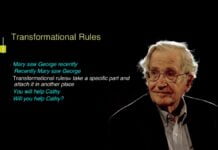There have been numerous changes in transformational grammar from the seventies onwards. Some of the important aspects of these changes are:
- Standard theory
- Extended Standard Theory (EST)
- Trace theory (REST)
- Case, Government and Binding Theory
Noam Chomsky’s Aspects of the Theory of Syntax, published in 1965, marked the beginning of the second phase in the history of transformational grammar. In 1966, he published topics in the Theory of Generative Grammar which contributed to the formulation of a new framework which is now known as the Standard theory. It was maintained in the Standard theory that the essential properties of the meaning of a sentence are represented in the deep structure of the sentence. Chomsky attempted to modify the Aspects model and the year 1970 marked the beginning of the next stage in the development of the transformational generative framework. Chomsky’s attempt to modify the Standard theory resulted in a modified version called the Extended Standard theory (EST). The rules here provided for sentence meaning by interpreting sentences through their structure, the lexical items they contained.
In 1975, Reflections on Languages was published in which Chomsky outlined the Trace theory or the movement rules (for some time it was also referred to as the Revised Extended Standard theory or REST). This modification brings sentence interpretation more to the surface level. The modification suggested is that transformation leave a trace of the constituents in the original position and that trace would then be available at the surface structures for semantic interpretation; the excess empty nodes will not be deleted as was suggested earlier in EST. The following example will illustrate this point.

Apart from the notion of ‘trace’, certain other modifications were introduced in REST. These were the introduction of Logical Form and Cognitive systems. These two contributed to the interpretation of surface structures. Logical Forms are quantifiers, negation, modals, topic, comment, reference, focus, presuppositions, anaphoric processes and the scope of logical elements. Elements of logical form are introduced by rules that apply to the surface structure to determine the surface semantic interpretation. Cognitive Systems are systems of internally organized rules concerning knowledge and belief that underlie languages and human behaviour.
In 1980, Chomsky made further revisions in the Trace theory and included certain notions like Case, Government and Binding. So the 1980 model is often referred to as GB. (Government and Binding).
The Government Theory
According to the Government theory, a verb in English governs its object and a preposition its complement. But due to recent studies in transformational grammar, the notion has been much broader than before. The recent notion refers not only to the above notions of verbs and prepositions but also to the tense governing the subject and the nouns, and the adjectives governing their complements. Chomsky, in his Pisa Lectures on Binding and Governance(1980) pointed out that an NP is marked nominative only if it is the subject of a tensed S.
- The villagers thought me to be brave.
- The villagers thought that I was brave.
In the first sentence, me is not a nominative case because it is the subject of a sentence that is not tensed. But in the second sentence, I is the nominative case because it is the subject of a tensed sentence.
The Binding Theory
The Binding theory deals with the specific conditions under which NPs are interpreted as co-referential with other NPs in the same sentence.
- Peter does his work himself. (reflexive)
- Peter and Mary support each other. (reciprocal)
- He is my brother. (reference in the context)
- Jacob thinks he cannot be promoted to the next class. (reference in an NP)
The Case Theory
The Case theory deals with the assignment of the case to NPs. Chomsky, in his book Knowledge of Language (1986), differentiated between types of case assignment: structural case and inherent case. The structural case is assigned under the government. For instance, tense governs and assigns the nominative case to the subject NP, a transitive verb an accusative case to its object, etc.
- He invited me to dinner.
The inherent case is assigned by nouns and adjectives to their NP complements. They assign an inherent genitive case, which is morphologically realized in the form of of.
- Peter’s consideration of his case.






























